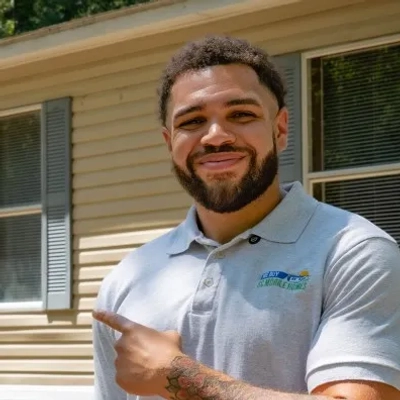21 Unconventional Objection Handling Techniques That Succeed When Traditional Approaches Fail
Discover 21 unconventional techniques that transform difficult objections into sales opportunities, based on insights from top-performing sales experts. These proven approaches work specifically when traditional objection handling methods fall short, giving sales professionals practical alternatives to common resistance points. Each technique offers a fresh perspective that shifts conversations from confrontational to collaborative, helping close more deals without resorting to high-pressure tactics.
Amplify Objections to Reveal True Value
When someone objects, I don't try to overcome or refute it. Instead, I amplify it.
For example, if a prospect says, "This feels expensive," I'll respond with "Yeah, it should because it's built for people who've already tried cheaper fixes that didn't work."
That changes the frame from defense to alignment. Rather than wrestling with the objection, I make it bigger until it reveals what they actually value.
It works because people want to feel understood. By agreeing with their hesitation and then reframing it through their own logic, I'm not selling against resistance but through it.

Calculated Reversal of Momentum Technique
Embracing the 'Why Not Now?' Pivot
The most unconventional objection handling technique I've successfully used, particularly in late-stage B2B deals that were stuck, is what I call the "Calculated Reversal of Momentum." When a prospect says, "We'll need to circle back next quarter" or "We need more time to think about it," which is the classic 'No Urgency' objection, the traditional approach involves validating their concern and scheduling a follow-up. Instead, I'd gently bring up our previous agreed-upon steps and ask: "Has something changed fundamentally since our last discussion, or did I miss something when we agreed to solve [their stated problem] by [their desired deadline]?"
This works by respectfully but firmly returning the responsibility for the delay to the prospect, forcing them to articulate the real, unspoken objection that's causing the roadblock. Traditional approaches fail here because they accept the surface-level excuse, letting the deal lose momentum and die. The reversal works because it leverages the psychological need for consistency and commitment—the client has to reconcile their current hesitation with the multiple "yeses" they've already given regarding the problem, the solution, and the timeline. What's more, nine times out of ten, they immediately disclose the actual issue, whether it's an internal political hurdle, a previously unmentioned decision-maker, or a budget technicality, allowing me to address the true root cause and move the deal forward strategically.

Reframe as Advice to a Friend
One of the most unconventional techniques I've used is asking a seller to imagine they weren't selling to me, but instead to their best friend or family member--then walking me through how they'd justify their asking price or concerns in that situation. It completely reframes the objection because people naturally cut through fluff when they picture giving advice to someone they care about. In one instance, a seller quickly realized the price they wanted wasn't realistic once they put themselves in the role of an adviser, which made it much easier to move forward together.

Coffee Chats Transform Business to Personal
An unconventional technique I've used is inviting a hesitant seller to join me for coffee away from the property, so we can talk like neighbors instead of buyer and seller. Changing the setting eases tension, and those real, distraction-free conversations often uncover what's truly holding someone back--sometimes it's not even about price or terms, but about feeling understood. I've seen these off-site chats turn deals around because they remind folks I'm here to solve their problem, not just make a transaction.

Blueprint Approach Shows Solutions Visually
I leverage what I call 'the blueprint approach' when handling tough objections. Rather than countering concerns verbally, I'll pull out paper and literally sketch how we'll solve their specific problem--whether it's structuring a creative financing solution or mapping out renovation potential. My construction background gives me the ability to show clients exactly how their challenges transform into opportunities. I had one seller who was convinced their fire-damaged property was worthless until I sketched out a detailed renovation plan right in front of them--they signed that day because they could finally see beyond the problem to the solution.

Turn Feature Gaps into Collaborative Opportunities
One of the most unconventional objection-handling techniques I've used is turning feature gaps into momentum, rather than letting them stall the deal.
When a prospect pointed out a missing capability, I didn't try to downplay it. Instead, I proposed a co-design pilot, a 4-6 week engagement with clear success criteria, ROI benchmarks, and an executive sponsor on both sides. At the same time, I introduced a forked-path plan: we launched a limited scope immediately to capture early wins, while structuring the broader rollout to take effect once the dependency was addressed. Both tracks were locked into a single SOW with stage-gates, so the buyer had confidence in progress without feeling like they were taking a gamble.
I think it worked because it flipped the script. What could have been a "no" turned into an invitation for collaboration. Instead of defending the gap, we created shared accountability and gave the prospect visible progress now with a path to full value later. Traditional objection handling often tries to minimize the concern, but this approach made the customer part of the solution, which built trust and urgency.
Neighborhood Walks Reveal Future Possibilities
One unconventional technique I've used is actually taking a walk with the seller through their neighborhood and asking them to point out homes they'd consider buying with their proceeds. This opens up a real, tangible conversation about their goals and the reality of the local market--suddenly, the sale isn't just about leaving something behind, but about what they're gaining. I think it works because it makes the next chapter feel concrete, not just theoretical, which helps people move forward when they're stuck on objections.

No-Commitment Walkthrough Removes Sales Pressure
When I sense a seller feels overwhelmed by the entire process, I offer to walk them through a "no-commitment walkthrough" where we pretend I'm not a buyer at all--just a consultant brainstorming next steps for them, even if that means keeping the house or listing it elsewhere. Relieving the pressure often leads them to open up, and many times they realize my offer genuinely aligns with their goals; it works because the conversation shifts from "selling" to simply solving their problem together with no strings attached.

Neighbor Comparison Grounds Price Expectations
I often use what I call the "neighbor comparison" technique. Instead of just giving market values, I'll ask sellers, "If your neighbor with the exact same house sold for X price last year, what makes your home fundamentally different or superior enough to command significantly more today, considering any repairs or updates needed?" It works because it grounds their expectations in a tangible, relatable example from their own street, making it less about my offer and more about understanding the reality of their immediate market.

Hand Clients the Marker and Whiteboard
I once brought a whiteboard to a client meeting and handed them the marker, saying, 'You tell me why this won't work.' It completely shifted the dynamic - suddenly they were trying to convince themselves while I listened and addressed each point they wrote down. It worked because it transformed what could have been an adversarial conversation into a collaborative problem-solving session. When clients articulate their own objections, they often realize some aren't as significant as they initially thought, and they become invested in finding solutions rather than just raising problems.

Share Personal Mistakes to Build Trust
One unconventional approach I've taken is sharing a mistake I made early in my real estate journey--like buying a fixer-upper that quickly turned into a money pit--to show sellers I truly understand their fears about risk and regret. Being open about my own missteps makes folks more comfortable dropping their guard, and it leads to honest conversations instead of rehearsed objections. Once they see I've been in their shoes, it's a lot easier to work together on a real solution.

Three Alternatives Redirect from Yes-No Decisions
I developed what I call the 'three alternatives technique.' When faced with a strong objection, I present three completely different solutions to their problem--including one seemingly outlandish option--rather than trying to overcome their original objection directly. This works brilliantly because it redirects the conversation from a yes/no decision to a choice between alternatives, engaging their problem-solving mindset. In one case, when a seller was convinced their mortgage note wasn't worth selling, I laid out three unconventional exit strategies, and they immediately gravitated toward the middle option that actually exceeded their original needs.

Ask Why Not Sell, Then Wait
One of the most unconventional techniques I've used is actually asking sellers to tell me why they *shouldn't* sell to me and then just sitting quietly. The silence often makes them reflect out loud, and many end up talking themselves into the deal without me having to push. It works because people trust their own reasoning more than any pitch I could give.

Project Life Six Months Without Selling
One of the most unconventional techniques I've used was asking a seller to walk me through what their life would look like *six months from now* if they decided not to sell. Instead of debating numbers in the moment, it made them confront the reality of ongoing stress--tax bills, repairs, and family tension. It worked because shifting the conversation from the property to their future gave clarity that traditional negotiation just couldn't touch.

Address Unmet Frustrations in Selling Process
One of the most unconventional techniques I've used is asking sellers to share the one thing that frustrates them most about the selling process--something no real estate agent has ever fixed for them. This usually opens up unexpected pain points, and when I address even a small grievance--like helping with leftover belongings or simplifying paperwork--it builds trust fast. I think it works because it signals genuine care, not just about closing, but about making their lives tangibly easier.

Role-Reverse to Let Sellers Discover Reality
I once role-reversed with sellers who were convinced their inherited property was worth way more than market value by having them play 'listing agent' and defend their price point to me as a 'potential buyer.' I asked pointed questions about comparables and needed repairs that they couldn't answer confidently. It worked because it allowed them to discover the reality gap themselves rather than me telling them they were wrong. When people reach conclusions on their own terms, their defenses don't kick in the way they do with traditional objection handling.

Bring Neutral Contractors for Transparent Assessment
One unconventional approach I've taken is to bring in a local, trusted contractor during a walkthrough--not to push my offer, but to let the seller ask their toughest questions about repairs or costs directly. Sellers see I'm not afraid of transparency, and when the numbers or challenges come from a neutral third party, it often dissolves skepticism. That openness turns objections into honest conversations about what's really possible for their home and their situation.
Connect Emotional Decisions to Loved Ones' Wishes
When homeowners object due to emotional attachment--like holding onto inherited property--I ask them to share a favorite memory of their loved one, then gently ask, 'What would they want for you today?' I had a client break down in tears realizing her father would've prioritized her financial freedom over keeping the house. Traditional tactics miss this emotional core, but honoring it transforms resistance into relief.

Sealed Envelope Technique Reveals True Needs
One of the most unconventional techniques I've used is inviting the seller to write down, privately, the minimum outcome they truly need--not want--from the sale, then sealing it in an envelope while we talk through the rest. This small exercise cuts through surface objections and gives them control, but it also encourages honesty, often revealing that we're much closer in expectations than they thought. When we finally open the envelope together, there's a lot less posturing--just two people trying to make the math work for both sides.

Challenge Sellers to Find Better Offers
When a seller was fixated on a specific, unrealistic price, I actually suggested they go get another offer, any offer, from another investor or agent, within 24 hours. I told them I'd wait. It worked because it showed I wasn't desperate or hiding anything; more often than not, they'd come back with a lower or similar offer, or no offer at all, realizing my original offer was fair or even generous relative to the market and the condition issues they had. Their trust went up significantly because I dared them to find better.
Let Product Experience Replace Abstract Arguments
One of the most unconventional objection handling techniques I've used was inviting a hesitant client to experience a demo of our simulator in a real training environment rather than continuing the discussion in a boardroom. The client was concerned about cost and ROI, and traditional responses around numbers and case studies weren't breaking through.
When they tried the simulator themselves, they noticed how quickly their team adapted, how safe the environment was for training, and how data from the sessions could directly improve performance. That hands-on experience shifted the conversation from "this is expensive" to "this can save us significant costs in accidents and downtime."
I think it worked because it replaced abstract arguments with tangible proof. In industries like mining and defense, clients are more convinced by what they can see and feel than by slides or reports. Sometimes the best way to overcome objections is to let the product speak for itself.





